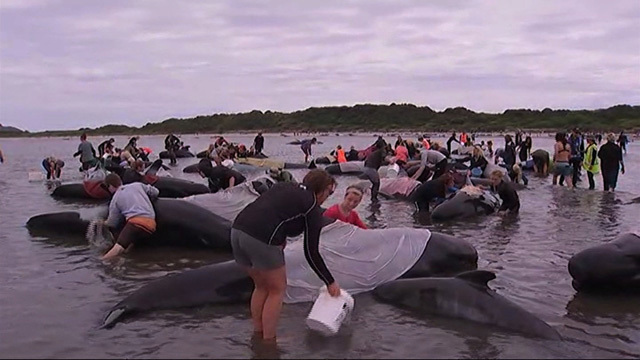Hundreds of Pilot Whales Die After Beaching in Farewell Spit
More than 350 whales died over the weekend, making this the third-largest mass stranding in the history of New Zealand.
“We are watching the bay at this time and hoping the pod swims into deeper water”, Project Jonah said of the group of over 200 whales in a post on Facebook.
The stranding has been one of the worst ever seen in New Zealand and lots of volunteers turned to help.
A department spokeswoman said those whales remained about two kilometers, or a little more than mile, off Pakawau in Golden Bay.
Rescuers attempted to refloat more than 100 whales mid-morning, of which about 50 returned to sea. More than 500 volunteers rushed to save them as well. However, after the fortunate turn of events, no more volunteers were needed after Sunday. It has although served as a reminder that without the human volunteers the damage may have been even greater. The refloat was partly successful with around 50 whales swimming out into Golden Bay.
“They swell up – there’s a lot of bacteria going on in their stomach – and the gut actually comes out of the animal and then blows”, Department of Conservation (DOC) spokesperson Andrew Lamason told Radio New Zealand.
DOC staffers said the agency took the decision to humanely euthanize the whales out of concern for their welfare.
They beached themselves about 3km from the Friday stranding.
Meanwhile, another pod of about 200 pilot whales were spotted around Taupata Point near Farewell Spit and officials feared another stranding Monday. The whales’ use of echo location becomes impaired in shallower water.
Environmentalists are concerned because the large amounts of decomposing whale could endanger the area’s wildlife and the local prawn harvest.
They were milling around in the shallow water so experts will be watching closely to check that they don’t strand themselves again. “There’s a lot of different theories”. After noticing some shark bites on one of the whales, he believes they may have been trying to escape risky prey.
Although scientists have not pinpointed any major reason for their occurrence, the shallow water in this location definitely plays a role as the gradual change in gradient may make it hard for the whales to spot it using echo-location, until it’s too late.








